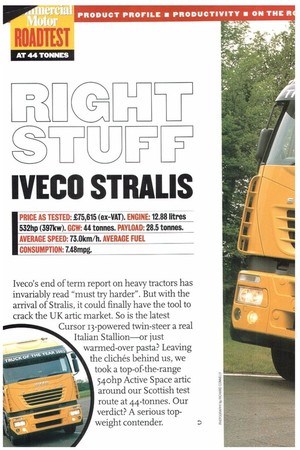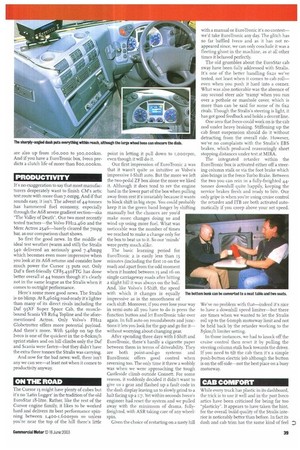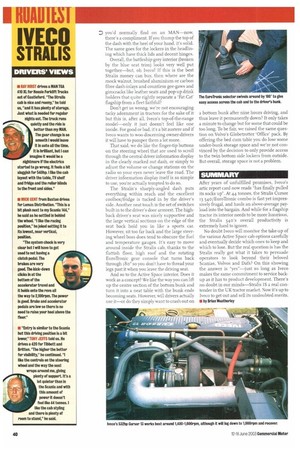IVECO STRALIS
Page 36

Page 38

Page 39

Page 40

If you've noticed an error in this article please click here to report it so we can fix it.
IPRICE AS TESTED: 175,615 (ex-VAT). ENGINE: 12.88 litres 532hp (397kw). GCW: 44 tonnes. PAYLOAD: 28.5 tonnes. AVERAGE SPEED: 73.0km/h. AVERAGE FUEL CONSUMPTION: 7.48mpg.
Iveco's end of term report on heavy tractors has invariably read "must try harder". But with the arrival of Stralis, it could finally have the tool to crack the UK artic market. So is the latest Cursor 13-powered twin-steer a real Italian Stallion—or just warmed-over pasta? Leaving the clichés behind us, we took a top-of-the-range 54ohp Active Space artic around our Scottish test route at 44-tonnes. Our verdict? A serious topweight contender.
aunched in a blaze of glory little more than iz months ago, Stralis is the truck that undeniably has to deliver the goods for Iveco in the UK as-tic market. It was 'make or break' time once before for the Italian Mick maker with EuroTech and EuroStar. So this is absolutely, positively the very last time to get it right.
Stralis is a very different beast to its predecessors, thanks to an all new cab and interior—although, reassuringly, it has proven Cursor io and 13 diesels to propel it. (When you're launching a new truck range it doesn't pay to change everything at once.) Having originally unveiled 'Active Space' Stralis as the old EuroStar's successor, the Italian truck maker recently completed the job with the launch of its 'Active Time' and 'Active Day' models (CM 24-30 April) which replace the EuroTech in the fleet sector.
However, all eyes will clearly be on the 'big' Stralis, and whether it can stake a claim in the flagship tractor arena. If it can, then Iveco could finally be seen as a credible rival to Scania, Daf and Volvo. If it can't... well, let's not go there.
PRODUCT PROFILE
Whatever happened to the days when trucks were called 'Super Bison', and that was it? The full nomenclature of our test artic (according to its spec sheet) is a tongue-twisting A S44o S54TX/P. Fortunately, with the secret pocket decoder it all makes perfect sense. AS=Active Space cab; 44oS54 is a 44-tonne GCW Stalls with a nominal 54ohp; T stands for tractor, Xis for twin-steer and, last but not least, P means the rear axle rides on air. Easy.
By any yardstick, the Stalls is "evolutionary, rather than revolutionary". Its basic chassis and drivetrain have been tried and tested in the EuroStar and EuroTrakker ranges. The r2.8-litre Cursor 13 six-pot is Iveco's 'big banger', boasting 532hp and 2,350Nm of torque on tap. Behind it sits the latest incarnation of ZF's AS-Tronic 16-speed, two-pedal direct-top auto box, sold in the Stalls under the EuroTronic banner. Iveco's faith in ZF's auto is clearly underpinned by the fact that it's the only box in town for a '540' engine, although you can still get a manual shift with the '480' rating.
Like its smaller Cursor ro and 8 siblings, the Euro-3 Cursor 13 has unit injectors driven by an overhead cam, plus a variable geometry turbocharger that can speed up the airflow when the revs are dropping, thereby increasing boost pressure and helping to overcome low-speed turbo lag. It also ensures maximum back pressure when you use the Iveco Turbo Brake—basically an engine compression device similar to a Jake. To aid cooler engine running, Iveco has increased the area of the Stralis's radiator and charge-cooler and added a new fan which cuts in more gradually. Altogether, the revisions are said to deliver a 1.5% saving in fuel consumption.
Although the Stralis cab retains a significant amount of the old EuroStar's sheet-metal core, it's got an all-new interior and updated exterior including more SMC panels in vulnerable areas. The full-width Active Space cabin comes with "a one-size-fits-all" standard high roof and sits on a new four-point air and damper suspension. Under the Active Space banner, there's a choice of three distinct interior configurations for single or double manning on local and long-distance work.
CMs test tractor boasted the 'Twin Driver' option with two bunks and a normal passenger seat that can also be rotated inwards by 90° to give more leg-room. In addition to the three basic interior layouts, you can also customise your Stabs cab to suit every driver whim—and most importantly from the owner's viewpoint, switch things back if vehicle usage changes.
Hidden away from the eye is a new multiplexed wiring system which uses CANbus technology to control every electrical component—not just the engine and gearbox. Consequently, the whole electrical system should now 'talk' to each component like never before, with fault diagnosis easier too. While sounding like an auto electrician's nightmare, Iveco insists it actually simplifies the wiring between the chassis and cab and within the cab itself. As an example, it cites the nearside electric window switches: previously in the EuroStar a three-wire circuit was needed between the two switches for the window; now each switch needs only a single wire from the local control point (plus earth) with another wire leading from the control unit to the window mechanism itself. If either switch breaks, the other still works.
Like other flagship rivals, the Stalls 6x2 boasts electronically-controlled disc brakes plus ASR as standard. The twin-steer's air-sprung mid-axle is fixed, rather than lifting—but manufacturer-approved lifting conversions are available in the UK. The 3.8m overall axle spread allows for a 450-litre ally tank in between. Power is laid down on the road via an ECAS-controlled Meritor drive axle. To save weight our test Stralis had Alcoa alloy rims.
Last but not least, by using fullysynthetic oils the Stralis's service intervals are up from ioo,000 to T 50, 000km while aide lube intervals
are also up from 160,000 to 3oo,000km. And if you have a EuroTronic box, Iveco predicts a clutch life of more than 800,000km.
PRODUCTIVITY
It's no exaggeration to say that most manufacturers desperately want to finish CM's artic test route with more than 7.0mpg. And if that sounds easy, it isn't. The advent of 44-tonnes has hammered fuel economy, especially through the A68 severe gradient section—aka "The Valley of Death". Our two most recently tested tractors—the Volvo F1-112.46 o and the Mere Actros 2546—barely cleared the 7mpg bar, as our comparison chart shows.
So first the good news. In the middle of ideal test weather (warm and still) the Stralis 540 delivered an seriously good 7.48mpg which becomes even more impressive when you look at its A68 returns and consider how much power the Cursor 13 puts out. Only Dais fleet-friendly CF85.430FTG has done better overall at 44 tonnes though it's clearly not in the same league as the Stralis when it comes to outright performance.
Here's some more good news. The Stralis is no blimp. At 8,460kg road-ready it's lighter than many of its direct rivals including the Daf 95X1" Super Space Cab, the musclebound Scania V8 13.164 Topline and the aforementioned Actros. Only Volvo's FF112 Globetrotter offers more potential payload. And there's more. With 54ohp on tap the Iveco is one of the quickest in the o-8olcm/h sprint stakes and on hill climbs only the Dal and Scania were faster—but they didn't have the extra three tonnes the Stralis was carrying.
And now for the bad news: well, there isn't any we can see—at least not when it comes to productivity anyway.
ON THE ROAD
The Cursor 13 might have plenty of cubes but it's no 'Latin Lugger' in the tradition of the old EuroS tar i8-litre. Rather, like the rest of the Cursor engine family, it likes to be worked hard and delivers its best performance spinning between 1,400-I,600rpm so unless you're near the top of the hill there's little
point in letting it pull down to L000rpm, even though it will do it.
Our first impression of EuroTronic 2 was that it wasn't quite as intuitive as Volvo's impressive 1-Shift auto. But the more we left the two-pedal ZF box alone the more we liked it. Although it does tend to rev the engine hard in the lower part of the box when pulling away from rest it's invariably because it wants to block shift in big steps. You could probably keep it in the green band longer by shifting manually but the chances are you'd make more changes doing so and wind up using more fuel. What was noticeable was the number of times we reached to make a change only for the box to beat us to it. So our 'minds' were pretty much alike.
The basic learning period for EuroTronic 2 is easily less than 15 minutes (including the first io on the road) and apart from the odd moment when it hunted between 15 and 16 on single carriageway roads after hitting a slight hill it was always on the ball. And, like Volvo's I-Shift, the speed with which it changes is equally impressive as is the smoothness of each shift. Moreover, if you ever lose your way in semi-auto all you have to do is press the function button and let EuroTronic take over again. In full auto on roundabouts and junctions it lets you look for the gap and go for it— without worrying about changing gear.
After spending three days with I-Shift and EuroTronic, there's hardly a cigarette paper between them in terms of driveability. They are both point-and-go systems and EuroTronic offers good control when reversing too. The only time it threw a wobbly was when we were approaching the tough Castles ide climb outside Consett. For some reason, it suddenly decided it didn't want to give us a gear and flashed up a fault code in the dash display leaving us to slowly grind to a halt facing up a 1:7. Yet within seconds iveco's engineer had reset the system and we pulled away with the minimum of drama, fullyfreighted, with ASR taking care of any wheelspin.
Given the choice of restarting on a nasty hill with a manual or EuroTronic it's no contest— we'd take EuroTronic any day. The glitch has so far baffled Iveco and as it has not reappeared since, we can only conclude it was a fleeting ghost in the machine, as at all other times it behaved perfectly.
The old grumbles about the EuroStar cab sway have been fully addressed with Stralis. It's one of the better handling 6x2s we've tested, not least when it comes to cab roll— even when you push it hard into a cornet What was also noticeable was the absence of any second steer axle 'tramp' when you run over a pothole or manhole cover, which is more than can be said for some of its 6x2 rivals. Though the Stralis's steering is light, it has got good feedback and holds a decent line.
One area that Iveco could work on is the cab nod under heavy braking. Stiffening up the cab front suspension should do it without detracting from the overall ride. However, we've no complaints with the Stralis's EBS brakes, which produced reassuringly short stopping distances under test at MIRA.
The integrated retarder within the EuroTronic box is activated either off a steering column stalk or via the foot brake which also brings in the Iveco Turbo Brake. Between the two you can rein in a fully-freighted 44 tonner downhill quite happily, keeping the service brakes fresh and ready to bite. Our only gripe is when you're using cruise control the retarder and ITB are both activated automatically if you creep above your set speed.
We've no problem with that—indeed it's nice to have a downhill speed limiter—but there are times when we wanted to let the Stralis roll up to the 6 omph motorway limit and not be held back by the retarder working to the 85km/h limiter setting.
In those instances, we had to knock off the cruise control then reset it by pulling the steering column stalk back towards the driver. If you need to tilt the cab then it's a simple push-button electric job although the button is on the off-side—not the best place on a busy motorway.
CAB COMFORT
While every truck has plastic in its dashboard, the trick is to use it well and in the past Iveco attics have been criticised for being far too "plasticky". It appears to have taken the hint, for the overall build quality of the Stralis interior is noticeably better than before. In fact its dash and cab trim has the same kind of feel you'd normally find on an MAN now, there's a compliment. If you thump the top of the dash with the heel of your hand, it's solid. The same goes for the lockers in the headlining which have thick lids and decent hinges.
Overall, the battleship grey interior (broken by the blue seat trim} looks very well put together—but, oh Iveco! if this is the best Stralis money can buy, then where are the mock walnut, brushed aluminium or carbon fibre dash-inlays and countless gee-gaws and gimcracks like leather seats and pop-up drink holders that quite rightly separate a 'Fat Cat' flagship from a fleet faithful?
Don't get us wrong, we're not encouraging tacky adornment in tractors for the sake of it but this is, after all, Iveco's top-of-the-range model—only it just doesn't feel like one inside. For good or bad, it's a bit austere and if Iveco wants to woo discerning owner-drivers it will have to pamper them a lot more.
That said, we do like the finger-rip buttons on the steering wheel that are used to scroll through the central driver information display in the clearly marked out dash, or simply to adjust the volume or change stations on the radio so your eyes never leave the road. The driver information display itself is so simple to use, you're actually tempted to do so.
The Stralis's sharply-angled dash puts everything within reach and the excellent coolbox/fridge is tucked in by the driver's side. Another neat touch is the set of switches built in to the driver's door armrest. The highback driver's seat was nicely supportive and the large vertical sections on the edge of the seat back hold you in like a sports car. However, sit too far back and the large steering wheel boss does tend to obscure the fuel and temperature gauges. It's easy to move around inside the Stralis cab, thanks to the flattish floor, high roof and the rotating EuroTronic gear console that turns back throught8ci° so you don't have to thread your legs past it when you leave the driving seat.
And so to the Active Space interior. Does it work as a concept? We like the way you can lift up the centre section of the bottom bunk and turn it into a neat table with the bunk ends becoming seats. However, will drivers actually use it—or do they simply want to crash out on
a bottom bunk after nine hours driving, and thus leave it permanently down? It only takes a minute to change but for some that could be too long. To be fair, we raised the same question on Volvo's Globetrotter 'Office' pack. By offering the bed aim table you do lose some under-bunk storage space and we're not convinced by the decision to only provide access to the twin bottom side lockers from outside. But overall, storage space is not a problem.
SUMMARY
After years of unfulfilled promises, Iveco's artic report card now reads "has finally pulled its socks up". At 44 tonnes, the Stralis Cursor I3 54o/EuroTronic combo is fast yet impressively frugal, and hauls an above-average payload into the bargain. And while for a flagship tractor its interior needs to be more luxurious, the Stralis 54,3's overall productivity is extremely hard to ignore.
No doubt Iveco will monitor the take-up of the various Active Space cab options carefully and eventually decide which ones to keep and which to lose. But the real question is has the Stralis really got what it takes to persuade operators to look beyond their beloved Scanias, Volvos and Dafs? On this showing the answer is "yes"—just so long as Iveco makes the same commitment to service backup as it has to product development. There's no doubt in our minds—Stralis IS a real contender in the UK tractor market. Now it's up to Iveco to get out and sell its undoubted merits. III by Brian Weatherley












































































































































































